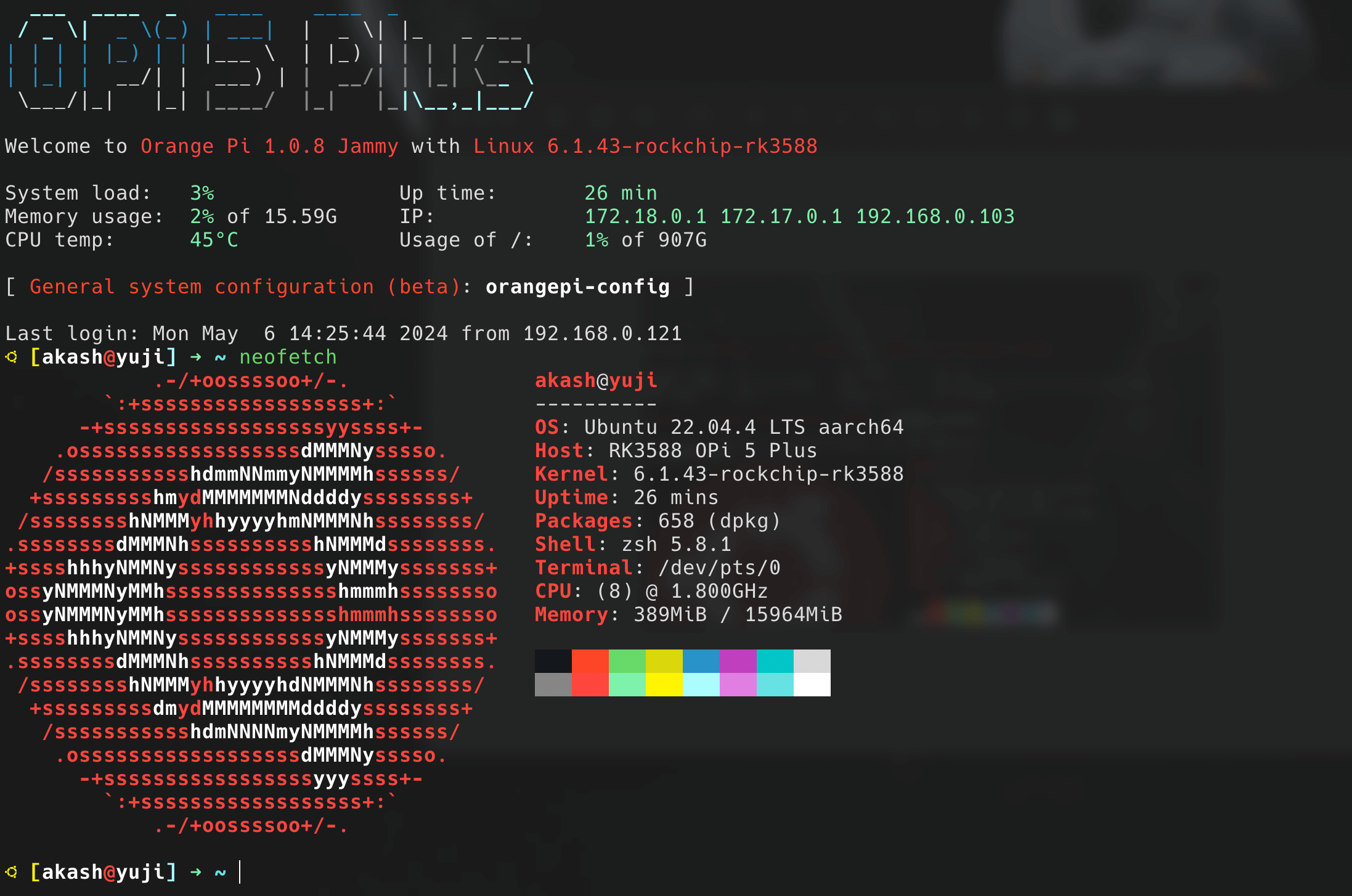Introduction
If you have read my self hosting in 2023 post, you might know that I have been using an old laptop and couple of Raspberry Pi’s for my homelab setup. I have been looking to add a new member to my homelab which can handle more heavy workloads and still be relatively power efficient. After some research, I decided to go with the Orange Pi 5 Plus and it is named as Yuji in my homelab.

Specs
Here are the specs of the Orange Pi 5 Plus:
- CPU: Rockchip RK3588 8-core 64-bit processor.
- RAM: 16GB.
- Storage: 1TB NVMe SSD (Western Digital SN770).
- Network: 2.5 Gbps Dual LAN ports.
- USB: 1x USB 3.0 Type-C port, 2x USB 3.0 ports, 2x USB 2.0 ports.
The major reason why I went ahead with this board is because of the RK3588 processor which is able to handle hardware transcoding. My goal here is to move Jellyfin from Sukuna to Yuji and use the hardware transcoding capabilities of the RK3588 processor ↗️.
Along with Jellyfin, I will also be able to leverage this hardware transcoding capabilities for other services like Immich ↗️ which I am planning to run on Yuji as well.
Will be sharing more about this in future blog when I have moved Jellyfin and Immich to Yuji and tested the hardware acceleration, if you are interested in this, stay tuned and subscribe via RSS or follow me on Twitter ↗️ / Reddit ↗️.
Initial Setup
I installed the latest version of Ubuntu Server (22.04 LTS) on the NVMe SSD and connected it to my network. I have also setup a static IP for Yuji via DHCP on my router (pretty much the standard stuff that I have for all my servers).
As I mentioned in a blog before that I have started using Ansible for managing my homelab, I have added Yuji to my Ansible inventory and added the necessary roles for my setup.
This was the most fun part, because after some initial manual work, I was able to bring Yuji to a state where I had all my server configurations like updating the SSH configs for better security, setup essential packages, setup ZSH and use my dotfiles configurations and many more within few minutes. This is the power of Ansible and I am loving it.
Enjoying the content? Support my work! 💝
Your support helps me create more high-quality technical content. Check out my support page to find various ways to contribute, including affiliate links for services I personally use and recommend.
What I will run on Orange Pi 5 Plus?
Well one thing is for sure, I will be moving Jellyfin from Sukuna to Yuji and use the hardware transcoding capabilities of the RK3588 processor. Apart from that, I am planning to run other services like Immich and some other services which I am planning to write about in my future blog posts.
This server is lot more powerful than other devices in my homelab, so I am still exploring how I can use it best and what all services I can run on it. If you have any suggestions or ideas, feel free to reach out to me on Twitter ↗️ / Reddit ↗️ and let’s discuss more on this.
I have one thought and I would love to hear your opinion on this. I am thinking of attaching more storage to it, essentially some harddrives and setup a NAS on it. The idea behind it is that I am already planning to run Jellyfin and Immich, both of which requires a good amount of storage.
So, If I have the drives directly attached to it, its much easier for the docker containers to access the file directories directly on the host since I read that it’s not recommended to mount shares to docker containers (I can use bind mounts but I haven’t tried it out and verified if these services work well with bind mounts).
So the idea is to attach some external harddrives via USB since the board has 2 USB 3.0 ports and 2 USB 2.0 ports. I am thinking of attaching 2x 4TB harddrives to it and setup a RAID for redundancy, and then I can also expose the directories to my network via NFS, what are your thoughts? Is this a good idea? Reach out to me on Twitter ↗️ / Reddit ↗️ and let’s discuss more on this or you can use the comment section below.
I’m excited to explore this new server and see how it performs, so far it is working great and I am happy with the performance. I will be sharing more about this in my future blog posts, so stay tuned!